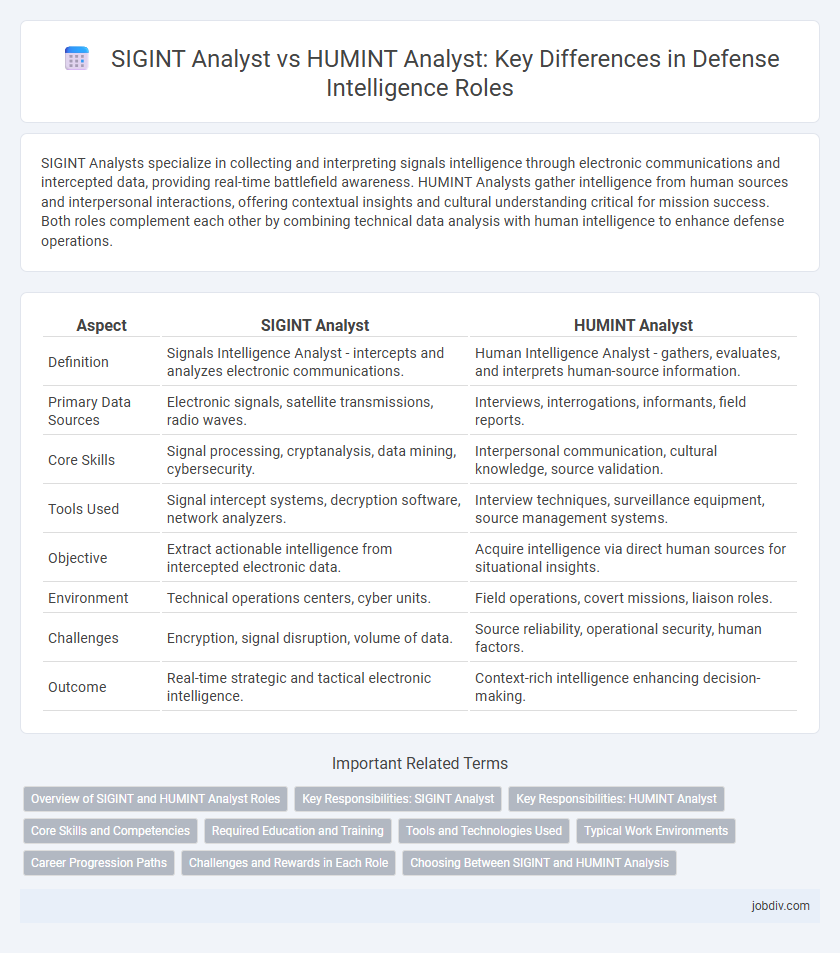SIGINT Analysts specialize in collecting and interpreting signals intelligence through electronic communications and intercepted data, providing real-time battlefield awareness. HUMINT Analysts gather intelligence from human sources and interpersonal interactions, offering contextual insights and cultural understanding critical for mission success. Both roles complement each other by combining technical data analysis with human intelligence to enhance defense operations.
Table of Comparison
| Aspect | SIGINT Analyst | HUMINT Analyst |
|---|---|---|
| Definition | Signals Intelligence Analyst - intercepts and analyzes electronic communications. | Human Intelligence Analyst - gathers, evaluates, and interprets human-source information. |
| Primary Data Sources | Electronic signals, satellite transmissions, radio waves. | Interviews, interrogations, informants, field reports. |
| Core Skills | Signal processing, cryptanalysis, data mining, cybersecurity. | Interpersonal communication, cultural knowledge, source validation. |
| Tools Used | Signal intercept systems, decryption software, network analyzers. | Interview techniques, surveillance equipment, source management systems. |
| Objective | Extract actionable intelligence from intercepted electronic data. | Acquire intelligence via direct human sources for situational insights. |
| Environment | Technical operations centers, cyber units. | Field operations, covert missions, liaison roles. |
| Challenges | Encryption, signal disruption, volume of data. | Source reliability, operational security, human factors. |
| Outcome | Real-time strategic and tactical electronic intelligence. | Context-rich intelligence enhancing decision-making. |
Overview of SIGINT and HUMINT Analyst Roles
SIGINT Analysts specialize in collecting and interpreting electronic signals and communications to provide actionable intelligence on enemy capabilities and intentions. HUMINT Analysts focus on gathering information from human sources through interrogation, surveillance, and liaison activities to assess adversary plans and networks. Both roles are critical for comprehensive situational awareness and strategic decision-making in defense operations.
Key Responsibilities: SIGINT Analyst
SIGINT Analysts specialize in intercepting and analyzing electronic communications and signals to provide actionable intelligence for defense operations. They monitor radar, radio transmissions, and satellite communications to identify threats and support battlefield awareness. Their expertise in cryptography, signal processing, and data exploitation is crucial for timely and accurate intelligence dissemination.
Key Responsibilities: HUMINT Analyst
HUMINT Analysts gather and interpret human intelligence by conducting interviews, debriefing sources, and analyzing information from human contacts to support military and defense operations. They assess the reliability and intent of human sources, providing actionable insights on enemy plans, intentions, and capabilities that are critical for operational planning. Their work involves collaboration with field operatives and security personnel to identify threats and support decision-makers with timely, accurate intelligence.
Core Skills and Competencies
SIGINT Analysts excel in signals interception, cyber analysis, and electronic data exploitation, requiring advanced technical skills, cryptographic knowledge, and proficiency in data analytics software. HUMINT Analysts specialize in human intelligence collection, cultural awareness, interrogation techniques, and source handling, demanding strong interpersonal communication and critical thinking abilities. Both roles require attention to detail, threat assessment expertise, and the ability to synthesize diverse intelligence sources for actionable defense strategies.
Required Education and Training
SIGINT Analysts require advanced education in electrical engineering, computer science, or cybersecurity, emphasizing signal processing and cryptography, with training focused on intercepting and analyzing electronic communications. HUMINT Analysts typically need a background in political science, international relations, or psychology, combined with specialized training in human intelligence collection techniques, source recruitment, and cultural awareness. Both roles demand rigorous security clearance and ongoing professional development to adapt to evolving intelligence methodologies.
Tools and Technologies Used
SIGINT analysts primarily utilize advanced signal interception and analysis tools such as software-defined radios, signal processing platforms, and encryption-breaking technologies to collect and interpret electronic communications and transmissions. HUMINT analysts rely on human source management systems, secure communication devices, and databases designed for debriefing and monitoring human intelligence activities. Both roles integrate analytic software, but SIGINT is heavily focused on technical signal exploitation, while HUMINT emphasizes interpersonal data collection and human source validation.
Typical Work Environments
SIGINT Analysts typically operate within secure communication centers, intelligence agencies, or military command posts where they intercept and analyze electronic signals and communications. HUMINT Analysts usually work in field offices, embassies, or forward operating bases, gathering and evaluating human-source intelligence through interpersonal interactions and covert operations. Both roles require access to classified information and collaboration with other intelligence units for mission success.
Career Progression Paths
SIGINT Analysts often advance through technical specialization, focusing on signals interception, data analysis, and cybersecurity roles, leading to positions like senior intelligence analyst or technical intelligence officer. HUMINT Analysts typically progress by enhancing interpersonal skills, source recruitment, and debriefing expertise, moving into roles such as senior human intelligence officer or operational intelligence manager. Both career paths offer opportunities for leadership in joint intelligence task forces or strategic policy development within defense agencies.
Challenges and Rewards in Each Role
SIGINT Analysts face challenges in intercepting and deciphering encrypted communications, requiring expertise in signal processing and cyber technologies, with rewards including real-time intelligence critical for national security. HUMINT Analysts navigate complex human networks and cultural nuances, often operating in high-risk environments to gather actionable intelligence, with personal fulfillment stemming from direct impact on counterterrorism and strategic operations. Both roles demand analytical precision and offer distinct contributions to defense intelligence.
Choosing Between SIGINT and HUMINT Analysis
Choosing between SIGINT and HUMINT analysis depends on the operational need for electronic intelligence or human-source information. SIGINT analysts specialize in intercepting and interpreting communications, signals, and electronic data, providing a broad view of enemy capabilities and intentions. HUMINT analysts focus on gathering and evaluating intelligence from human sources, offering context, motivations, and insights that technical means may not reveal.
SIGINT Analyst vs HUMINT Analyst Infographic

 jobdiv.com
jobdiv.com